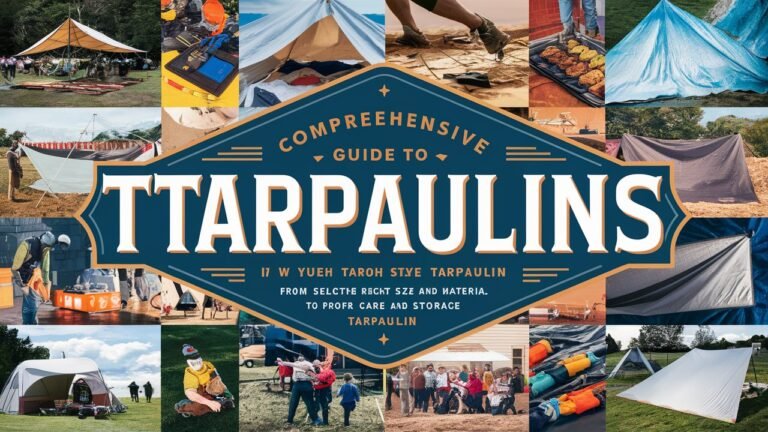Tarpaulins, often referred to as tarnplanen in German, are one of the most versatile and practical materials used across industries, households, and outdoor environments. Whether for construction sites, gardening, camping, agriculture, transportation, or storage, tarpaulins provide reliable protection against harsh weather, dust, and external elements. In this comprehensive guide, we will explore everything you need to know about tarnplanen, from their types and applications to buying tips and maintenance strategies.
What is a Tarnplanen?
A tarnplanen is a strong, flexible sheet made from materials such as polyethylene, PVC, or canvas, usually coated or laminated to ensure water resistance and durability. Designed with reinforced edges and eyelets, tarnplanen can be secured easily to cover, protect, or shield valuable goods and spaces. Their adaptability makes them indispensable for both personal and industrial purposes.
Types of Tarnplanen
Understanding the different types of tarpaulins helps you select the right one for your needs.
1. Polyethylene Tarnplanen
These are the most commonly used, lightweight, and affordable. Poly tarps are ideal for temporary coverings, gardening projects, and short-term construction use. They are water-resistant and come in various thicknesses.
2. PVC Tarnplanen
PVC tarpaulins are highly durable, heavy-duty, and completely waterproof. They are used in transportation covers, truck tarps, industrial storage, and outdoor shelters. Their resistance to UV rays and harsh conditions makes them long-lasting.
3. Canvas Tarnplanen
Canvas tarps are breathable, strong, and eco-friendly. They are perfect for applications requiring air circulation, such as covering machinery or agricultural products. Although not entirely waterproof, they are resistant to mildew and tearing.
4. Mesh Tarnplanen
Mesh tarpaulins allow partial airflow and light penetration. These are commonly used in scaffolding, fencing, shade provision, and agriculture to protect plants while ensuring ventilation.
Popular Uses of Tarnplanen
The versatility of tarpaulins extends to countless areas of life and industry.
1. Construction and Renovation
Construction sites rely heavily on tarnplanen to cover building materials, protect scaffolding, and shield unfinished structures from rain and dust. Heavy-duty tarps help maintain safety and efficiency on-site.
2. Agriculture and Farming
Farmers use tarpaulins to cover crops, protect harvested goods, and create temporary storage shelters. Tarnplanen also play a role in animal husbandry, offering weather protection for livestock.
3. Transportation and Logistics
Truck drivers and logistics companies depend on PVC tarpaulins for cargo protection. These tarps prevent goods from being damaged by rain, snow, or road debris, ensuring safe delivery.
4. Camping and Outdoor Recreation
For campers, a tarnplanen is an essential tool. It can serve as a tent groundsheet, rain shelter, or windbreaker. Lightweight tarpaulins are especially handy for hiking and backpacking trips.
5. Household and Garden Use
In homes and gardens, tarpaulins are useful for covering firewood, protecting outdoor furniture, and acting as a temporary carport. They provide an affordable solution for day-to-day weatherproofing needs.
Key Features to Consider When Buying Tarnplanen
When selecting the right tarpaulin, several important features should guide your decision:
-
Material Strength: Choose polyethylene for light use, PVC for heavy-duty, and canvas for breathable coverage.
-
Water Resistance: Ensure it is suitable for your weather conditions—PVC is fully waterproof, while canvas is water-resistant.
-
UV Protection: For outdoor use, UV-resistant coatings extend the lifespan of the tarp.
-
Reinforced Edges and Eyelets: Look for rust-resistant grommets and double-stitched hems for secure fastening.
-
Size and Thickness: The thickness (measured in microns or GSM) determines durability, while size should match the area to be covered.
Benefits of Using Tarnplanen
The advantages of incorporating tarnplanen into daily activities and industrial practices are extensive:
-
Durability: Resistant to tears, punctures, and extreme conditions.
-
Cost-Effective: Affordable compared to permanent structures.
-
Portability: Lightweight and easy to fold, carry, and store.
-
Versatility: Adaptable for countless applications.
-
Reusable: Long-lasting when maintained properly.
How to Maintain Tarnplanen for Longevity
Proper maintenance ensures that your tarnplanen lasts for years.
-
Regular Cleaning: Wash with mild soap and water to remove dirt, mold, and debris. Avoid harsh chemicals that may damage coatings.
-
Dry Before Storage: Always dry thoroughly before folding to prevent mildew growth.
-
Store Properly: Keep in a cool, dry place, away from direct sunlight.
-
Inspect Frequently: Check for holes, tears, or weakened eyelets, and repair promptly with tarp tape or patches.
-
Avoid Sharp Edges: When securing, ensure it does not rub against sharp corners that could cause tearing.
Eco-Friendly Aspects of Tarnplanen
With growing environmental concerns, many manufacturers now produce recyclable and biodegradable tarpaulins. Canvas tarps, for instance, are naturally eco-friendly and reusable, while some modern polyethylene tarps are made from recycled plastics. Choosing sustainable options not only benefits the planet but also aligns with eco-conscious practices in industries and households.
Where to Buy High-Quality Tarnplanen
Quality tarpaulins are available at hardware stores, outdoor equipment shops, construction supply outlets, and numerous online retailers. When purchasing, always check product reviews, warranty details, and supplier reliability to ensure you receive durable and genuine products.
Conclusion
A tarnplanen is more than just a protective sheet; it is a practical solution for countless challenges in construction, farming, transportation, outdoor activities, and household use. By understanding the different types, applications, and maintenance methods, you can make the most of this versatile tool. Investing in a high-quality tarpaulin ensures long-term durability, weather resistance, and cost efficiency, making it an indispensable item in both professional and personal life.
Frequently Asked Questions (FAQ)
1. Are all tarnplanen waterproof?
Not all are fully waterproof. Polyethylene and PVC tarps are waterproof, while canvas is only water-resistant.
2. What size of tarpaulin should I buy?
Choose a size slightly larger than the area you intend to cover for maximum protection.
3. Can tarnplanen withstand heavy snow?
Yes, heavy-duty PVC and reinforced tarps can handle snow loads, but regular inspection is necessary.
4. How long does a tarpaulin last?
With proper care, tarpaulins can last anywhere from 2 to 10 years, depending on material and usage.
5. Is it safe to use tarnplanen for food storage?
Yes, provided the tarp is food-safe certified and used correctly to prevent contamination.
